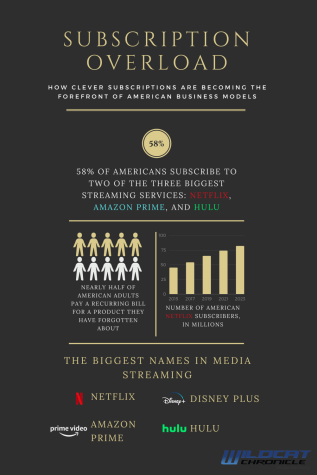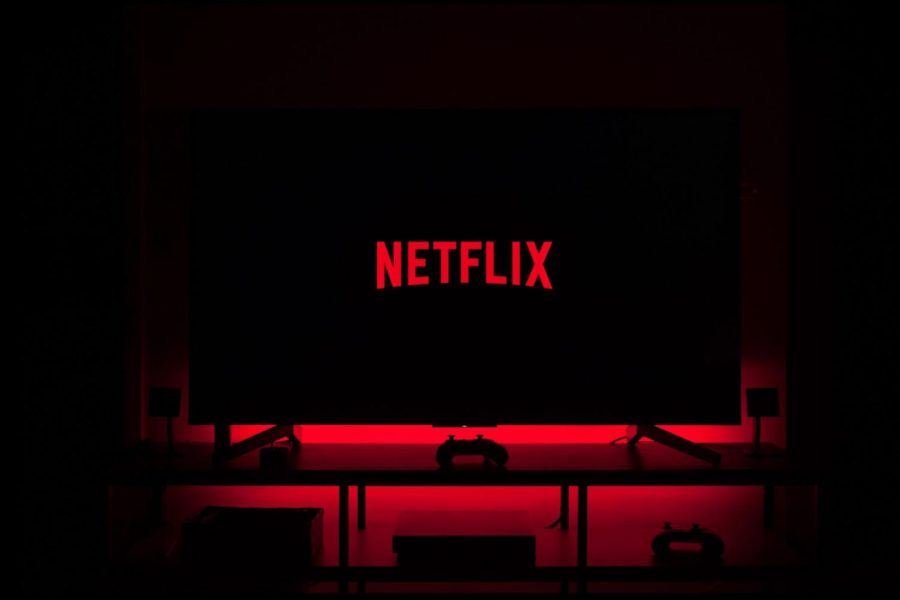Subscription overload: what a changing economy means for the consumer
Netflix is the most popular media streaming platform in the world. (Photo used with permission by Pixahive user Deepak).
March 7, 2023
Netflix. Disney+. Amazon Prime. The list goes on. Subscription services and recurring billing have taken over the business model for media and virtual products, and it shows no sign of letting up. Nearly every online industry offers a service of some kind, generally to streamline an experience or to gain “exclusive” access to certain features. Still, virtual streaming is easily becoming one of the most atrocious examples of when corporate competition unfairly impacts the consumer.
Gone is the age of owning media. Subscriptions are your new best “friend.”
Families often have to pay for multiple streaming services in order to watch the shows they want. Disney, one of the world’s largest entertainment providers for children, holds nearly all of their titles on their Disney+ program, despite operating at a net loss. And the typical American family also pays for Netflix to cater to their teenage and adult members, the price of which has doubled over the past decade, due to waning profits and excessive inflation.

In fact, inflation was (and still is) one of the root causes of the rise in entertainment prices. Following the outbreak of COVID-19 and Russia’s war against Ukraine, nearly everything increased in price. Cars (used and new), gasoline, housing, and food were among the most impacted, but prices for online services also rose dramatically. Thankfully, inflation has been tamed in recent months as the economy steadily recovers from global instability.
It is hard to imagine a world where owning media is still relevant, but subscriptions have demonstrated that competing services do not always mean better deals for the consumer. Disney+ was originally created so that Disney could take market share away from Netflix, but neither company has been able to maintain or offer fair prices for their platforms. The greatest concern is that despite their lack of competition, Netflix and Disney+ are still gaining more users by the month. YouTube is another offender, as they have introduced double-ads before videos (a decent majority of which cannot be skipped) in order to further promote their Premium service which disables ads for $11.99 per month.
Studies show that nearly 45% of adults pay for subscriptions that they do not use or have forgotten about, and this is costing them nearly $100 more per month than they expected. As entertainment continues to get increasingly divided among brands, the total cost of enjoying media increases due to the overflow of largely superfluous subscriptions that are needed to watch just a few shows or movies.
Your car is no longer “your” car.
One look at American city design reveals the exact method of transportation that is prioritized: cars. It does not matter if you live in the heart of the Chicago Loop or out in the suburbs, the prevalence of automobiles is everywhere, and people like to be comfortable during their commutes.
However, certain car manufacturers are beginning to lock features that are strictly hardware-based behind paywalls. Recently, brands such as Mercedes now charge up to $1,200 a year for the use of an “acceleration upgrade” for certain electric vehicles, which decreases the 0-60mph time by one second. It should be noted that no physical changes are made to the vehicle upon purchase; only the computer software of the car has been changed.
Additionally, heated and ventilated seating is something that BMW is now charging for, which was previously a one-time payment of a luxury package, and is often included with the vehicle. This came directly after receiving backlash for charging $80 a year for Apple Carplay, which nearly every other manufacturer offers for free with a compatible display.
Luxury features are not the only things that are being restricted behind paywalls. Toyota recently disabled remote start on their new vehicles, and after a certain trial period ends, a recurring bill will need to be paid through the Toyota app in order to continue to use the remote starter. Vehicles from the 2018 to 2020 model years will have a three-year trial, while brand-new vehicles will have a ten-year trial. The most disturbing part is that remote start has been a free feature for certain vehicles before this point, and Toyota is now marketing this service as something that is brand-new, as implicated by their slogan “Making Ownership Easier.” Toyota’s Connected Services is actively making ownership more difficult.
The more troubling concern for this trend seems to be that electric vehicles are the cars receiving the most subscription services. While car companies may want to make up for lost revenue from gasoline and maintenance, these practices are going too far, too quickly. Over-the-air upgrades are a good idea in concept, but the lack of physical alteration to a car means that these “products” are not real products. Instead, these upgrades are just bills for items that the consumer has already bought; despite advertising campaigns marketing the idea as a way to “unlock” the full potential of a vehicle, its “potential” is arbitrarily limited. EVs are the future for personal transportation, so it is clear that corporations may hold subscriptions from vast numbers of American drivers within the next 10-20 years; all for technology that they have already purchased. While this kind of business model may work now, only time will tell if subscriptions are a fair practice when EVs become the key to America’s cities.
Where is the line drawn?
So, the question for the consumer is whether or not these virtual subscription membership fees are worth it, and it looks as if “no” is becoming the most obvious answer, even if it may be the most convenient.
After the outbreak of COVID-19, large portions of the country signed up for streaming services as a way to quench boredom during the lockdown, which eventually led to about 58% of Americans subscribing to two or more of the big three: Netflix, Hulu, and Amazon Prime.
The most dangerous precedent is that consumers are okay with paying for things they do not need. While it is great that consumers can pick and choose exactly what they want out of a product or service, it is evident that companies are abusing this business model to make the most money possible. From the customer’s perspective, subscriptions begin to blend together and become increasingly difficult to justify purchasing.
In the end, it seems like subscriptions are the way of the future, for better or worse.














![[PHOTO ESSAY] Behind-the-scenes with Chief of Police, Mike McLean](https://wildcatchronicle.org/wp-content/uploads/2024/04/Police-7-2023-Zach-Wiegele-2-600x429.jpg)
